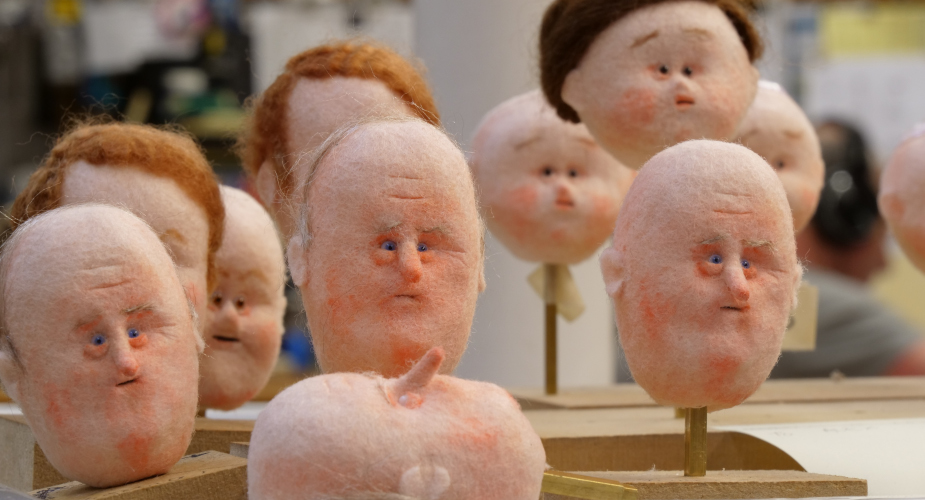
Netflix's The House Blurs Genre Lines with Its Disturbing Warmth

“And heard within, a lie is spun.”
These are the first words from the first chapter the audiences read at the beginning of The House, a three part stop-motion series produced by Nexus Studios, that plays on the nerves of viewers with its dark humour and visuals that really… stay with you. Each part of the series was directed by different directors – first by Emma De Swaef and partner Marc James Joels, follows the story of a young family moving into a new home, only to find out that something isn’t quite right.
The second, by director Niki Lindroth von Bahr, tells us about a mouse developer that has put his entire life into fixing up a house that he is desperate to sell, which ends in a series of very unfortunate events. And the third, a charming and warm story about a cat landlady, preoccupied with the refurbishment of her rental apartment building, that is never ready to let go, is directed by Paloma Baeza. What ties all of these stories is, of course, the communal setting of The House – an eerie building, heavy with symbolism, that the characters seem to collide with in somewhat similar (but also crucially different) ways.
The crew behind The House got the green light for production to start in January 2020 and the process finished in August 2021. "Crazy short for our standards," says Emma. During a big chunk of those two years, the four directors were scattered all over the world, but were eventually able to get together in Manchester in England at the studio, to oversee the production process. Although they've spent much of the production physically apart, the team seems to have gelled quite well in more than one way – when they talk to me about the initial idea and the first steps, I really feel that connection they’ve built.
“I think it’s just been such an amazing experience,” admits Niki. “It was a bit intimidating in the beginning, but collaborating creatively with these geniuses and making such good friends with them was incredible. Being able to share good or bad, getting their creative input on scriptwriting – every part of the way, I haven’t been feeling alone, which is just so comforting.”
Intimidating is one of the first words that come to mind when one looks at the style and scope of the stop-motion production. Not only due to the collaboration effort between four directors, but also because of the level of detail and craft in the animation. “For our chapter specifically, the effects were all done on set,” recalls Emma. “It’s quite a big challenge, trying to do effects like fire and wind. Those sorts of huge cluster movements are much easier to do in CG. We worked together with our animation director Tobias Fouracre and he developed a flame system for us. Then, the more we did the fire scenes, the better we got at more ambitious things with them. Towards the end of the film, we were able to spread the fire and make it bigger.”
Emma shares a fascinating insight into the logistics of the fire scenes; the crew had to hold flickering lights near the puppets, in order to mimic the fire reflecting on their faces.
“We basically tried to shoot the film as if computers hadn’t existed,” laughs Marc.

As interesting as the construction of the environmental elements like fire, wind and surroundings are, the real magic lies in the character designs and how these intriguing characters are brought to life: their differences and common traits, and how each of them fits within their own story. After all, having one house shared at different times by humans, cats and mice is perhaps not the simplest thing to ease audiences into. “With human puppets, it’s really hard to nail it down,” says Paloma, reflecting on the challenges behind the creation of characters developed by Marc and Emma for the first part of the series.
Paloma adds: “Sometimes, when not done right, they look kind of real, but not quite. They can come out a little bit creepy, or they’re in the uncanny valley territory. It’s a really difficult thing to do in terms of character design, to have something that’s pleasing and relatable, and with a human form, whereas in animals it seems to be much easier, because you can take the animal shape and find your own version of it. For me there are certain animals I want to explore and tell stories with and cats were one of them. It feels like cats were just right for this story, the right expression of aesthetic.”

Funnily enough, Niki thought the same about her story, except with mice. “Both me and Paloma work with animals, but in very different ways. I’ve always worked with them in previous projects, but in this film I was very interested in exploring the animal self in different layers. I have real animal insects, I have the mouse, who has sort of a human form (and acts human) in the face of the developer, and I have the odd couple, which are insect animals pretending to be mice – a really odd hybrid. My main character, towards the end, actually regresses and becomes the true animal that he is and finds some kind of salvation in that.”
Watching the three stories, viewers can't help but wonder about the connection between the choice of characters, but one thing was sure – each personality fitted perfectly with their own rendition of the experience of what The House is. As each faces their own demons within that communal space, each episode raises as many questions as it answers: what is the time proximity between the three stories? Are they even in the same universe (Paloma’s story is quite literally set in the middle of nothing)? How do they exist in reference to each other? What other common themes are there between them but their home?

“We didn’t start with any recurring themes in mind,” reveals Paloma. “We thought if, by chance, we could find things that overlap we would let them develop organically.” When having the same breeding ground for three essentially different stories, it’s natural for them to progressively bounce off each other in fascinating ways.
“When we came up with this concept of using the house as this arena to work within, we all knew that the characters and concepts across the three stories would be hitting up against this house in some way,” says Marc. “I think it was really organic, the way they emerged. So we didn’t worry too much about that. We took the concept of the house in our little bubbles and worked it out, we knew that because it shares a communal space, things will naturally flow from one into the next and they won’t feel contrived.”
Not only does the concept of the house provide the dancefloor on which these three stories naturally flow in and out of each other, but it also stands as a separate character in itself. “The House is loaded with so many symbolism – the house as a status maker, the house as a wealth and prestige ladder that the characters try to climb, but also the house just as a home. The human need to search for a home, to feel safe away from this messed up world. Even though we didn’t plan for mutual themes, I do believe we have them, especially when it comes to humanity and the true struggles of being human,” explains Niki.
A good story (or in this case – three good stories) provide the viewer with plenty of possibilities for reading into them. However, it is evident that watching each chapter in a vacuum might take away from the overall experience of The House. Emma recalls the emotional connection that the three stories seem to exude. “Somehow mine and Marc’s story opens up a bit of a wound and doesn’t have closure. Then it becomes very dark and funny in Niki’s film, and then the viewer gets a lot of closure in Paloma’s film. There’s an emotional arc there, which we didn’t plan for. I always tell people, don’t watch just our chapter, watch the three films together.”
And of course, nothing is ever coincidental. “I do think there was a purpose in bringing us together as directors from Nexus,” shares Niki. Watching the series, one cannot get over the common overriding feeling of disturbance, something looking over your shoulder, the strategic silences and the incredible usage of music. Something in all of these stories tugs onto the viewer’s heartstrings in ways that aren’t quite explainable – to me, it combines the freedom that animation gives to the expression of unsettlement (remember the mix of media in Courage the Cowardly Dog that made all of us squirm as children) and the deep darkness that happens to underline most good humour. I have personally always been interested in the ways comedy intertwines with horror, and although The House is put down as a drama comedy, it definitely transcends those genres to become its own hybrid breed. Stepping carefully on that thin line between funny and deeply disturbing, all three stories work with music, silence, stillness and comedy in ways that leave the viewer confused about what exactly to feel.
“I always aim for horror, but it sometimes becomes more fun. My aim is mainly to keep the audience unsettled about the whole atmosphere – Is this fun? Or is it very disturbing? Or neither?”. To Niki these contradictions within the same story should be embraced and built upon. The old fashioned borders of comedy and horror no longer seem to serve what creators really want to make, neither what audiences are hungry for. “I think the thing we have in common as directors is that we all like a sense of humour intertwined with absurdity,” agrees Paloma. “We all like elements of darkness. The absurdity and that darkness pull in different directions in all three films – I think I’m much more fuzzy and warm in a funny kind of way. But there’s still the tricky weirdness that I like. We all do slightly different things with the same areas of darkness.”

Besides this, one of the most peculiar insights the directors gave me is that the absolutely brilliant Gustavo Santaolalla, who worked on the music of the series, is actually to be credited for the Tibetian throat singing in the third chapter. “When I had the first Zoom call with him, he felt that he landed on the perfect script for him, because he was there with his white beard, burning incense and holding a crystal. And one of my characters is exactly that. He told me ‘I’ve always had this thing that I’ve wanted to do that I can do but haven’t had the chance.’ And he then just went into the throat singing,” says Paloma.
Ultimately, crafted in its own beautiful way, with well rounded characters and three separate storylines that can be viewed from multiple angles, The House is truly a work of art that stays with the viewer and is worth the second glance. Stories that touch on greed, fear, envy, anger, family and friendship, but ultimately try to pick apart the horrifying and terribly funny reality of what being human means – without putting the human (or sometimes non-human) in the scary outside world, but by confining him to some unidentifiable ‘inside,’ that he so desperately wants to turn into a home.
“I think the overriding feeling at the end of my film, and ultimately, the whole series, is the feeling of hope. Hope in the face of adversity,” reflects Paloma. Because, at the end of the day, we are all just people looking to find a home.













